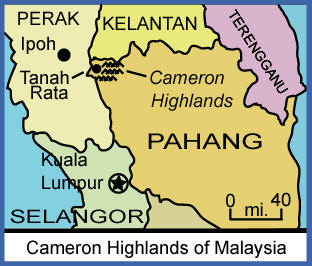Heavy rains early last week caused a landslide to roar down on a Semai community near the resort town of Tanah Rata, at the western edge of the Cameron Highlands in Malaysia, killing seven people and seriously injuring two others. Initial estimates were that the community had 145 homes with about 1300 people in them when the landslide hit. Fortunately, only three houses were completely buried and a couple others were damaged.
 The community, Sungai Ruil, is a couple kilometers off the road from Tanah Rata to Brinchang, about 5 km to the northeast. Tanah Rata is one of the most important tourist centers for the Cameron Highlands resort area.
The community, Sungai Ruil, is a couple kilometers off the road from Tanah Rata to Brinchang, about 5 km to the northeast. Tanah Rata is one of the most important tourist centers for the Cameron Highlands resort area.
The Semai in Sungai Riul, according to one news report, no longer do much hunting for small game in the forest. They now subsist on selling forest products they have gathered and from wage laboring jobs. Their homes are built from planks and concrete rather than from thatch as they used to be.
The dead and the injured were taken to the hospital in Tanah Rata, while other survivors who lived in the immediate area of the landslide were evacuated to a multi-purpose hall in Brinchang. Those who were seriously injured were then moved to a hospital in the city of Ipoh, below the highlands to the west.
By the afternoon the next day, Social Welfare Department officials had decided to start distributing aid to the 523 victims of the landslide who had been evacuated to Brinchang. Later in the day, it became clear that over half of the community, 666 people, had been relocated to that community hall.
Soon various authorities began to speculate on the causes of the landslide. Tengku Abdullah Sultan Ahmad Shah, the crown prince of Pahang State, in which the Cameron Highlands is located, said that the landslide “was due to water retention at the hill [where] the houses were located. There was [a] spring up there on the hill.”
However, since the land on the mountainside above the settlement is controlled by the Semai, there had apparently not been any serious logging or earth-moving operations. Observers spoke of trees being uprooted and brought down by the landslide, so why the mountainside was unstable remains unclear. A couple days after the tragedy, state authorities maintained that it did not occur due to land clearing or development. It was completely a natural disaster. Others are not convinced, however, and suspect that land clearing may, in fact, have been a cause.
Two German tourists who happened to be in the area when the disaster occurred told the press late the next day that they were impressed by the efforts of the community and the rescue crews when they searched for survivors. One of them described the spirit of mutual assistance that she witnessed in the aftermath of the tragedy.
Several press reports quoted the experiences of the Semai themselves. One quoted Harun Bahsoon, a 41 year old man, who saw a bolt of lightning hit the hillside just before the mudslide started.
“It was a creepy kind of an explosion when the soil came down,” he said. “I rushed out of my house with my wife and four children to help save those buried. Other villagers joined in. It was raining heavily and we ourselves were standing in waist deep mud and soil while trying to pull the victims out.” He went on to describe how he helped pull his neighbors out of the mud, but one of the men was gasping for breath. He died just as the rescue crews arrived.